Modern Identity and Access Management (IAM) is no longer solely focused on identity governance, authentication, and authorization. It has evolved into a dynamic ecosystem where identities, attributes, and policies require efficient management and seamless interoperability across multiple services to ensure better security, holistic governance, and more value-added identity workflows.
This shift requires Identity Orchestration as a strategic approach to implementing an “Identity Fabric” or an “Identity Mesh”, ensuring flexible and interoperable identity services that can extend their reach beyond traditional IAM tools (IGA, IDP, PAM, authorization) into cybersecurity tools such as physical access, network security, SIEM, CIEM, and ITDR.

The Role of Identity Orchestration
Identity Orchestration enables organizations to unify disparate IAM tools and data sources with other types of business data that represent key enterprise structures needed to enable new and dynamic access scenarios.
A well-designed Identity Fabric connects identity services into a flexible, unified system. Rather than centralizing all processes in one orchestrator, the focus is on ensuring that existing IAM tools share reliable and qualified data and communicate efficiently using standardized protocols.
The Data Foundation for Optimizing IAM
Effective Identity Orchestration relies on strong data management. Without a solid foundation, identity services can become fragmented, creating security risks and operational inefficiencies. By normalizing identity and asset data, Identity Orchestration ensures consistent, high-quality data is always available for IAM services and other tools. This allows services to securely access standardized, contextual identity data via REST and SCIM-based APIs, reducing redundancy and inconsistencies.
Benefits of efficient data management:
- Breaks down silos, reducing data duplication and inefficiencies
- Ensures a reliable and accessible single source of truth for identities and assets
- Enables real-time updates and seamless synchronization across IAM services
- Enhances governance and compliance with clear visibility into identity and access data
A Shared Process Layer for Workflows, Events and Signals
For seamless cross-service identity operations, organizations need to implement a shared process layer. This layer enhances existing IAM workflows and enables new autonomous processes on top of the orchestrated data. An Identity Orchestration tool needs to support both human-, system- and data-driven events, integrating with external systems through synchronous and asynchronous (signals) data exchanges.
Benefits of a shared process layer:
- Automates identity and access workflows beyond IGA (e.g., physical security, application lifecycle management, VPN security, security clearance)
- Extends identity verification and IGA workflows (e.g., provisioning, deprovisioning) in high-security scenarios
- Enables collection of critical identity, verification, and governance data in a coordinated workflow
- Streamlines integrations by enabling multiple services to respond to identity events
- Strengthens IAM security with real-time event-driven signals for data exchange
Holistic Identity Governance
Identity governance plays a vital role for most organizations as security threats and regulatory compliance demands are rapidly increasing. With Identity Orchestration, organizations can begin to focus on a broader set of governance controls than those currently targeted by IGA tools. These tools are designed to handle identities, accounts, and their association with entitlements. Identity Orchestration provides the capability to consolidate and visualize a more comprehensive view of identities and their relationships with the enterprise. With this enhanced view, organizations can now start to automate more modern and value-adding governance workflows.
Benefits of holistic identity governance:
- Visibility and reporting across the identity ecosystem beyond accounts and entitlements
- Operationalizing relevant governance control points (current and future) by linking them to applications, information types, and application/information owners
- Continuous compliance through actionable compliance controls
Conclusion
Identity Orchestration is the key to building an Identity Fabric, providing organizations with a scalable and efficient IAM ecosystem. By focusing on data normalization, standardized integrations, and visibility, organizations can optimize their IAM strategy and elevate their security posture and compliance support.
A well-orchestrated identity ecosystem not only simplifies identity management but also strengthens the foundation for Zero Trust security, adaptive access controls, and future-ready digital transformation.


